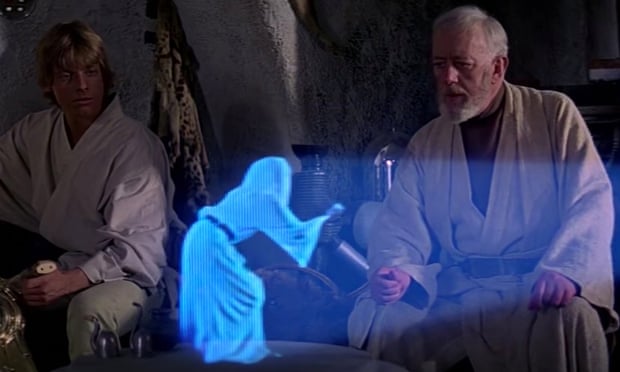A demonstration of the display showed a butterfly flapping its wings, a countdown spelled out by numbers hanging in the air, and a rotating, multicoloured planet Earth. Beyond interactive digital signs and animations, scientists want to use it to visualise and even feel data.
While the images are similar, the device is not the sort of holographic projector that allowed a shimmering Princess Leia to enlist Obi-Wan Kenobi’s help in Star Wars. Instead, it uses a 3D field of ultrasound waves to levitate a polystyrene bead and whip it around at high speed to trace shapes in the air.
The 2mm-wide bead moves so fast, at speeds approaching 20mph, that it traces out the shape of an object in less than one-tenth of a second. At such a speed, the brain doesn’t see the moving bead, only the completed shape it creates. The colours are added by LEDs built into the display that shine light on the bead as it zips around.
Because the images are created in 3D space, they can be viewed from any angle. And by careful control of the ultrasonic field, the scientists can make objects speak, or add sound effects and musical accompaniments to the animated images. Further manipulation of the sound field enables users to interact with the objects and even feel them in their hands.
Sriram Subramanian, a researcher on the team, said that besides digital signs, the display could be used for new forms of visual entertainment. “Let’s say you want to create a Harry Potter experience. You could put your hand out to cast a spell and as you move your hand you could see and feel a glowing ball growing in your palm, and we could have sound coming from it too,” he said.
Ryuji Hirayama, who helped build the display, said it had been a long-term dream to make such a device. But he sees the “multimodal acoustic trap display” as a step towards more sophisticated systems. “I believe that in the future, such displays will allow us to interact with our family and friends as if they are close by, so you can see, touch and hear them,” he said.
The images are created between two horizontal plates that are studded with small ultrasonic transducers. These create an inaudible 3D sound field that contains a tiny pocket of low pressure air that traps the polystyrene bead. Move the pocket around, by tweaking the output of the transducers, and the bead moves with it.
The most basic version of the display creates 3D colour animations, but writing in the journal Nature, the scientists describe how they improved the display to produce sounds and tactile responses to people reaching out to the image.
Speech and other sounds, such as a musical accompaniment, were added by vibrating the polystyrene bead as it hares around. The vibrations can be tuned to produce soundwaves across the entire range of human hearing, creating, for example, crisp and clear speech. Another trick makes the display tactile by manipulating the ultrasonic field to create a virtual “button” in mid-air.
The prototype uses a single bead and can create images inside a 10cm-wide cube of air. But future displays could use more powerful transducers to make larger animations, and employ multiple beads at once. Subramanian said existing computer software can be used to ensure the tiny beads do not crash into one another, although choreographing the illumination of multiple beads mid-air is another problem.
If the technology can be improved, it could transform 3D printing by building objects from tiny droplets of different materials that are levitated and dropped into place.
Euan Freeman at the University of Glasgow said the technology showed the potential for displays in the future. “With this technology, you could reach out and feel the digital images shown in the display,” he said.
“The interesting thing about the tactile content is that it’s created using ultrasound waves. Unlike the simple vibrations most people are familiar with through smartphones or games consoles, the ultrasound waves move through the air to create precise patterns against your hands. This allows multimedia experiences where the objects you feel are just as rich and dynamic as the objects you see in the display.”
Julie Williamson, also at Glasgow, said levitating displays are a first step towards truly interactive 3D displays. “I imagine a future where 3D displays can create experiences that are indistinguishable from the physical objects they are simulating,” she said.
The Guardian
More about: Hologram















































